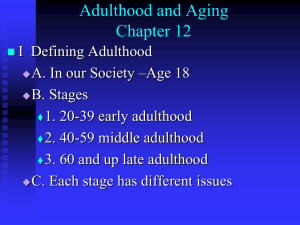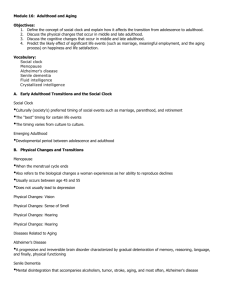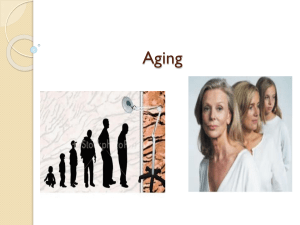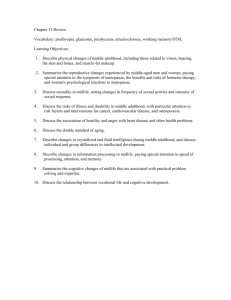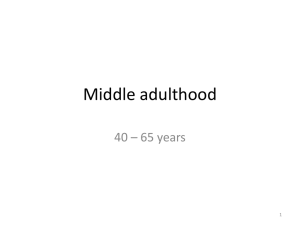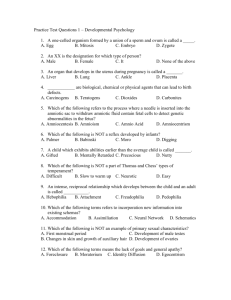NOTES_Adulthood_Individual Development in Psychology
advertisement
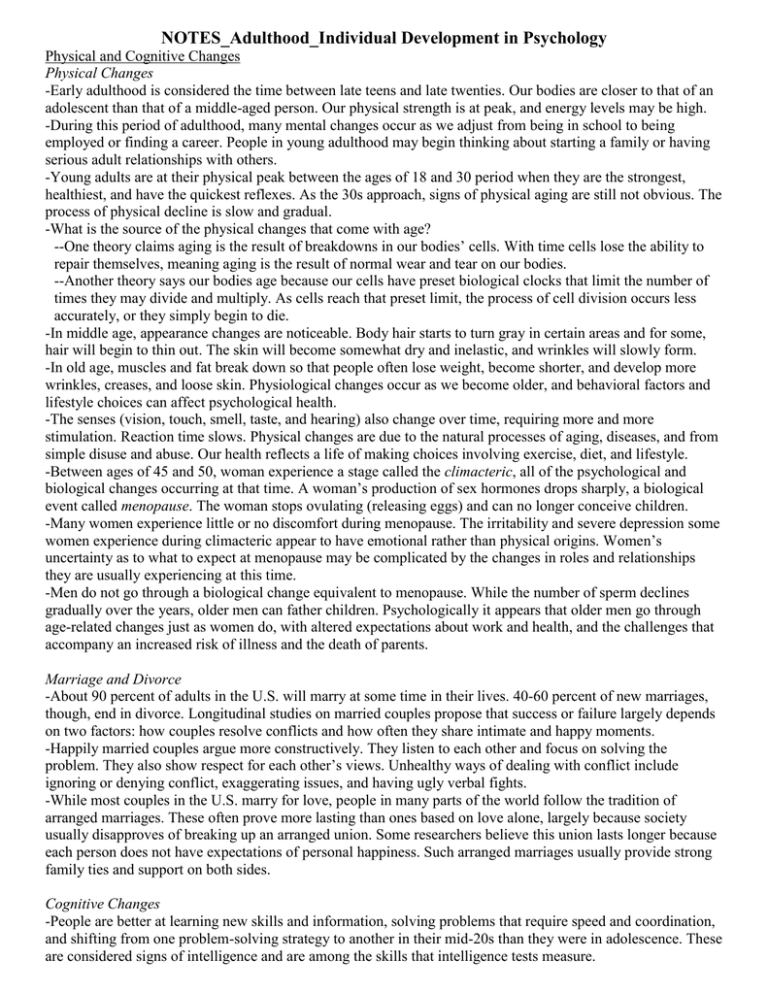
NOTES_Adulthood_Individual Development in Psychology Physical and Cognitive Changes Physical Changes -Early adulthood is considered the time between late teens and late twenties. Our bodies are closer to that of an adolescent than that of a middle-aged person. Our physical strength is at peak, and energy levels may be high. -During this period of adulthood, many mental changes occur as we adjust from being in school to being employed or finding a career. People in young adulthood may begin thinking about starting a family or having serious adult relationships with others. -Young adults are at their physical peak between the ages of 18 and 30 period when they are the strongest, healthiest, and have the quickest reflexes. As the 30s approach, signs of physical aging are still not obvious. The process of physical decline is slow and gradual. -What is the source of the physical changes that come with age? --One theory claims aging is the result of breakdowns in our bodies’ cells. With time cells lose the ability to repair themselves, meaning aging is the result of normal wear and tear on our bodies. --Another theory says our bodies age because our cells have preset biological clocks that limit the number of times they may divide and multiply. As cells reach that preset limit, the process of cell division occurs less accurately, or they simply begin to die. -In middle age, appearance changes are noticeable. Body hair starts to turn gray in certain areas and for some, hair will begin to thin out. The skin will become somewhat dry and inelastic, and wrinkles will slowly form. -In old age, muscles and fat break down so that people often lose weight, become shorter, and develop more wrinkles, creases, and loose skin. Physiological changes occur as we become older, and behavioral factors and lifestyle choices can affect psychological health. -The senses (vision, touch, smell, taste, and hearing) also change over time, requiring more and more stimulation. Reaction time slows. Physical changes are due to the natural processes of aging, diseases, and from simple disuse and abuse. Our health reflects a life of making choices involving exercise, diet, and lifestyle. -Between ages of 45 and 50, woman experience a stage called the climacteric, all of the psychological and biological changes occurring at that time. A woman’s production of sex hormones drops sharply, a biological event called menopause. The woman stops ovulating (releasing eggs) and can no longer conceive children. -Many women experience little or no discomfort during menopause. The irritability and severe depression some women experience during climacteric appear to have emotional rather than physical origins. Women’s uncertainty as to what to expect at menopause may be complicated by the changes in roles and relationships they are usually experiencing at this time. -Men do not go through a biological change equivalent to menopause. While the number of sperm declines gradually over the years, older men can father children. Psychologically it appears that older men go through age-related changes just as women do, with altered expectations about work and health, and the challenges that accompany an increased risk of illness and the death of parents. Marriage and Divorce -About 90 percent of adults in the U.S. will marry at some time in their lives. 40-60 percent of new marriages, though, end in divorce. Longitudinal studies on married couples propose that success or failure largely depends on two factors: how couples resolve conflicts and how often they share intimate and happy moments. -Happily married couples argue more constructively. They listen to each other and focus on solving the problem. They also show respect for each other’s views. Unhealthy ways of dealing with conflict include ignoring or denying conflict, exaggerating issues, and having ugly verbal fights. -While most couples in the U.S. marry for love, people in many parts of the world follow the tradition of arranged marriages. These often prove more lasting than ones based on love alone, largely because society usually disapproves of breaking up an arranged union. Some researchers believe this union lasts longer because each person does not have expectations of personal happiness. Such arranged marriages usually provide strong family ties and support on both sides. Cognitive Changes -People are better at learning new skills and information, solving problems that require speed and coordination, and shifting from one problem-solving strategy to another in their mid-20s than they were in adolescence. These are considered signs of intelligence and are among the skills that intelligence tests measure. NOTES_Adulthood_Individual Development in Psychology -An adult’s reaction time begins to slow after a certain age. Intelligence tests usually penalize adults for this. Even with a decline in speed, people continue to acquire information as they grow older. The ability to comprehend new material and to think flexibly improves with years and experience. -One researcher studied more than 700 individuals who were engaged in scholarship, science, or the arts. Although the patterns varied from profession to profession, most of the participants reached their peaks of creativity and productivity in their 40s, but in the humanities (history, foreign languages, and literature) most reached their peaks later in their 50s or 60s. Social and Personality Development -An individual’s basic character, the way they adapt to situations, remains relatively stable over the years. Researchers gave the same attitude and personality tests to individuals in late adolescence and again 10 or 15 years later. Many participants believed they changed dramatically, but the tests indicated that they had not. The degree of satisfaction they expressed about themselves and about life in general in their middle years was consistent with their earlier views. --Confident young people remained confident, those prone to pessimism remained pessimistic, and passive individuals remained passive—unless something upsetting had happened. -Even though basic character remains relatively stable, people do face many changes in their lifetimes and will need to adjust accordingly. Adults encounter new developmental tasks, just as adolescents do. They too must learn to cope with problems and deal with new situations. Learning the skills needed to cope with change seems to occur in stages for both adult males and females. Levinson’s Theory of Male Development -In the 1920s, Daniel Levinson proposed a theory for adult development of men consisting of important structures and transitions, lasting for five years in 6 stages: 1) Early Adult Transition (age 17-22) - leave adolescence, make preliminary choices for adult life 2) Entering the Adult World (age 22-28) - make initial choices in love, occupation, friendship, values, lifestyle; resolve between the desire to explore the options of the adult world and the need to establish a stable life. 3) Age 30 Transition (age 28-33) - changes occur in life structure (moderate or severe); tentative commitments made in the first life structure are reexamined, and questions about choices of marriage partner, career, family, and life goals are reopened; any unsatisfying or incomplete parts of his life must be attended to now. 4) Settling Down (age 33-40) - establish a niche in society, progress on a timetable in family and career accomplishments; expected to think and behave like a parent so face more demanding roles and expectations. 5) Mid-life Transition (age 40-45) - life structure comes into question, usually a time of crisis in the meaning, direction, and value of each person's life. -A successful “Midlife Transition” is accompanied by becoming a mentor to a younger person. This event signals the attainment of generativity, the desire to use one’s wisdom to guide future generations. This can take place directly or indirectly. Stagnation, discontinuation of development can occur if they hang on to the past. 6) Entering Middle Adulthood (age 45-50) - choices must be made, new life structure formed; true adulthood can be achieved -The man who finds satisfactory solutions to his life’s transitional periods reaches a period of stability. He understands and tolerates others, and displays a sensitivity and concern for them. He is able to strike a balance between the need for friends and the need for privacy. -Levinson’s eras and transitions are based on averages from many individual interviews. Nobody’s life is likely to match Levinson’s divisions exactly, and even though the theory was developed with men in mind, many women may go through these same stages regarding their families, careers, and lives. Female Development -Adult women today face many of the same challenges as men, and some challenges that are their own. Some get married and have children, while others do not. Still others raise their families on their own. -Evidence does not support a midlife crisis for women. Women may be facing difficulties earlier in adulthood. Some balance the roles of parent and career. Others wait until their children are older to reenter the workforce or go back to college. It may be a time of opportunity for those who opted to have a family first. NOTES_Adulthood_Individual Development in Psychology -A significant event in many women’s lives is the moment the last child leaves the home. This event is not traumatic for all women, though it can be difficult for some. A stable marriage makes a difference. If a woman has a warm relationship with her husband, she may find the adjustment easier because of his support. If the woman is widowed or divorced, the transition could be more difficult. -Depression is common among middle-aged women. During the early years a woman may find a sense of worth from the roles of daughter, wife, and mother. These roles change as children grow, parents die, and marriages fail. Some women experience a sense of loss and personal worthlessness. -The onset of menopause can trigger depression. Those who have defined themselves as child bearers may view themselves as useless. Some women welcome this time of life. Career women can draw a new sense of selfesteem from their work. Many women find satisfaction in new activities and experiences, developing interests and friends apart from their children. Old Age -Many attitudes about aging are based on a decremental model of aging, which holds that progressive physical and mental decline is inevitable with age. There are numerous physical differences among the elderly, and these differences are more a matter of genetic background and environment. This view in our society is due to ignorance and lack of contact with older people which creates a climate of prejudice against the old, ageism. -The majority of older Americans work or wish to work either for pay or as volunteers. Older people are not inflexible or senile, the person who is rigid in old age was most likely rigid as a young adult. -Physical strength and the senses decline about 1 percent a year through adulthood. Good health in adolescence and adult life carries over into old age. A healthy lifestyle in adulthood will lead to physical wellness in old age. All people are subject to disease. Major causes of death among the old are heart disease, cancer, and strokes. -The quality of health care for the elderly is inferior to that of the general population. Reasons for this include: elderly tend not to take care of themselves or to seek out treatment when needed; some doctors prefer younger patients with acute diseases rather than to older patients with long-term chronic conditions that cannot be cured; and some doctors hold stereotypical views of the elderly leading to misdiagnosis/improper treatment. -Some older adults no longer able to care for themselves live with relatives or in institutions (nursing homes) that may/may not provide adequate care for them. -In late adulthood, life’s transitions such as retirement and widowhood can be negative, reduce responsibilities, and increase isolation. The person may lose not just a spouse but friends and family. -The symptoms of depression are very common in older adults as many have suffered through the challenges common in this stage of life. Weight change, feelings of worthlessness, extreme sadness, inability to concentrate, and thoughts of death and suicide are often cited. Depression can often be amplified by unhealthy habits formed over the course of adulthood. -Older people today continue to learn and develop new skills more frequently than ever before. Some attend night school, local adult education classes, or take up new hobbies. Older adults’ abilities such as nonverbal tasks and problem solving may decline, but other abilities remain normal and some even improve with age. -On a more personal level, older people often encounter opposition from family and friends if they want to remarry after the death of a spouse. Children may find the idea of love in old age ridiculous or disgusting. -Many of the changes the elderly face make their adjustment to everyday life more difficult because they represent a loss of control over their environment. When older people are unable to maintain what they value most the quality of their lives suffers dramatically, along with their self-image. -The loss of control is usually gradual, and it may involve both physical changes and external circumstances. Those who experience a loss of control in old age often develop a negative self-concept. They can regain a sense of control and rebuild a positive self-image if they are helped to make the best of those options available. -As people age, there are also changes in their mental functions, with less decline in intelligence and memory than commonly assumed. There are many different types of mental skills and abilities that combine to produce intellectual functioning, and these abilities do not develop at the same rate or time across the life span. --Factors such as physical health, vision, hearing, coordination, the speed or timing of intelligence testing, and attitudes in the testing situation all affect intelligence test scores. -John Horn has proposed two types of intelligence: crystallized and fluid intelligence. Crystallized intelligence refers to the ability to use accumulated knowledge and learning in appropriate situations. This ability increases NOTES_Adulthood_Individual Development in Psychology with age and experience. Fluid intelligence is the ability to solve abstract relational problems and to generate new hypotheses (gradually increases in development as the nervous system matures). --As people age and their nervous systems decline, so does their fluid intelligence. A decline in the nervous system affects reaction time, visual motor flexibility, and memory. Elderly people have more difficulty retrieving information from memory. -A small percentage of people in old age develop dementia, conditions characterized by memory loss, forgetfulness, disorientation of time and place, a decline in the ability to think, impaired attention, altered personality, and difficulties in relating to others. Dementia has many causes and some are treatable at this time. --While a decreased cognitive functioning is normal, dementia is a condition diagnosed by a doctor and not a part of the normal developmental processes as described by Levinson and others. -The most common form of dementia among the elderly is the neurological disease known as Alzheimer's Disease, is a gradual deterioration of cognitive functioning. Early signs of the disease include frequent forgetfulness, poor judgment, increased irritability, and social withdrawal. --Eventually Alzheimer’s patients lose their ability to comprehend simple questions and to recognize friends and loved ones. Ultimately they require constant supervision and care, often from trained professionals. Causes of Alzheimer’s are complex and still not completely understood. Dying and Death -Death is inevitable and it is not just biological. When a person dies, there are legal, medical, psychological, and social aspects that need attention. -Biological death becomes entangled with social customs. These customs include cultural attitudes toward death, care of the dying, the place where death occurs, and efforts to quicken or slow down the dying process. Social and cultural aspects of death (disposal of the dead, mourning customs, and role of the family) are intertwined with our own thoughts and values about dying and death. Stages of Dying -Once patients with a terminal illness have been informed of their condition, they must then cope with many changes as they approach death. -Elisabeth Kübler-Ross’ work on how the terminally ill react to their impending death made a major contribution in establishing thanatology, the study of dying and death. She identified five stages of psychological adjustment. Stage 1: Denial. Most people are in shock and numb which leads to denial. They may assert the doctors are incompetent or the diagnosis mistaken. People may refuse treatment and persist in going about business as usual. Most patients in denial have become accustomed to coping with difficult life situations in this way. Stage 2: Anger. Reaction is to feel angry at fate, the powers that be, at every person who comes into their life. They may alienate themselves from others because of their short life span and lost chances. Stage 3: Bargaining. People change their attitude and attempt to bargain with fate. This stage is relatively short and is followed by the stage of depression. Stage 4: Depression. Dying people are aware of the losses they are incurring and are depressed about the losses to come: losing everybody and everything. People must be allowed to express their sadness and not to cover up the situation or force them to act cheerfully. Stage 4: Accept death. The struggle is over, and they experience a sense of calm. The approach of death feels appropriate or peaceful. They seem to become detached intentionally so as to make death easier. -Not all terminal patients progress through the stages that Kübler-Ross describes. Some people may go through the stages but in different order, or they may repeat some stages. Individuals are unique and sometimes do not follow predictable patterns of behavior. -Kübler-Ross notes that patients do not limit their responses to any one stage; a depressed patient may have recurring bursts of anger. All patients preserve the hope that they may live after all. -Camille Wortman and others have argued Kübler-Ross’s stages simply identify the five most common styles of dealing with death, with no need to progress through stages. NOTES_Adulthood_Individual Development in Psychology -Once a person has died, loved ones left behind may go through a distinct and emotional grieving process. British psychologist John Bowlby established a framework for understanding how people deal with grief, based on attachment: Stage 1: shock and numbness. A person is at first stunned by loss of a loved one/knew well. They may have trouble concentrating, or their judgment or functioning may be impaired. Depending on the attachment between the person and the deceased, this stage may last several hours to several weeks. Stage 2: yearning and searching. Grieving person tends to withdraw from others, perhaps asking questions about life and death and yearning for the loved one that was lost. Guilt and anger over the loss of the person may happen People who have spent most of their adult lives with a loved one may have an especially hard time, and it may last for several months. Stage 3: disorientation and disorganization. The person may become depressed and the loss of their loved one becomes especially real in their minds. At the same time, they seem disoriented in their new reality. Stage 4: reorganization and resolution. When the loved one finally gets over the isolating sadness of losing their loved one. They can feel joy again and feel more energy and confidence. They establish a new level of normality in their lives. -Some people experience Bowlby’s grieving stages out of order, for different lengths of time, or may skip some stages altogether. Understanding the stages has been helpful for people going through the stages of grieving, as well as for counselors or analysts helping people through their grief. -Bowlby has also adapted strong ideas of attachment to individuals such as family members. The more attached someone is to a loved one who dies, the more difficulty they may have grieving the loss of that person. This is especially true for spouses, children, or other loved ones who helped to make decisions regarding the loved one’s end of life care.

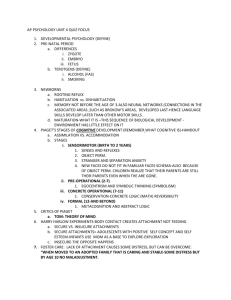

![Adulthood andaging[1]](http://s3.studylib.net/store/data/009423432_1-4447cad1799ab03eaf7339901cd9d417-300x300.png)
